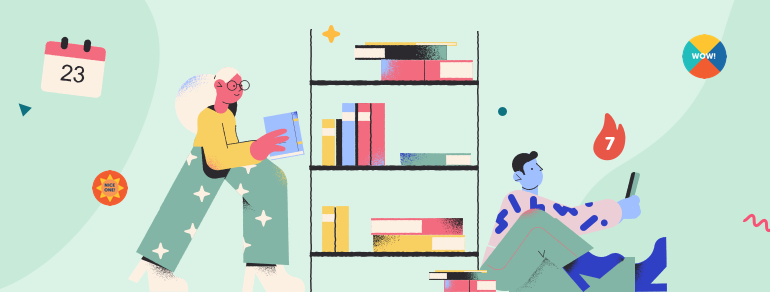At Beanstack, we strongly believe in the value of reading for fun, not only because we are avid readers ourselves, but also because studies show that it can boost academic achievement, foster empathy, and support life-long learning. That's why we were alarmed when a recent survey by Pew Research Center revealed a concerning trend: the percentage of 9- to 13-year-olds who say they read independently is plummeting. In fact, the current figures are the lowest they've been since the mid-1980s. In the same study, Pew found that half of the 9-year-olds performing at or above the 75th percentile on standardized reading tests say they read for fun almost every day.
It's clear that reading for fun makes an impact—so what can we do to turn this troubling trend around? According to Beanstack data, reading challenges are a powerful tool for educators and librarians who want to build a reading culture in their communities and improve academic performance. Here's why it works:
Gamification encourages kids to develop a daily reading habit
Gamification is a simple way to encourage students and patrons to see reading as a fun challenge, not a chore. Additionally, it encourages students to read in their free time. The Beanstack mobile app utilizes gamification to incentivize students to complete challenges and create reading streaks by logging their minutes every day. Whether it is fiction or non-fiction books that are read, every minute counts!
And it works—data from our 2021 Summer Reading Report proves that participants who have a reading streak, no matter how long, are more likely to read the next day. Similarly, badges at key reading milestones also motivate students to keep reading and become frequent readers. Our Summer Reading Report showed that reading challenges with at least 10 badges encourage more students and patrons to participate in the challenge and keep participants logging longer.
Shared goals and competition build community and make reading fun
While gamification features inspire students to achieve personal goals, many school and public libraries also use community goals to encourage healthy competition and collaboration among students and patrons. Creating lofty shared goals, such as reading 1 million minutes a year, urges readers to pitch in and read every day.
Encouraging friendly competition can also help. Danielle Masterson, a youth services librarian at Wilmington Memorial Library in Massachusetts, found that building competition into her library's reading challenge made a huge difference in engagement. For their reading challenge, Wilmington Memorial Library pitted their patrons against another nearby town, which they already competed against in an annual Thanksgiving Day football game. "It was amazing to watch the kids get so into it," Masterson says. "We created an interactive bulletin board, and kids would run in to see if we were winning. One kid saw that we were losing and yelled, 'Oh come on!' Then, he added: 'We gotta get home to read!'"

Recognizing students' achievements inspires them to keep reading
Reading challenges don't just work because they encourage students and patrons to set and achieve their goals. They also tap into our need for recognition and positive reinforcement. Usually, independent reading, whether it is at the elementary, middle, or high school level, goes unnoticed. A teacher or librarian might compliment a student on their passion for reading, but there's no grade attached to leisure reading or reading for pleasure. But with a reading challenge, readers do receive acknowledgment, in the form of badges, prizes, and more.
Ashlei Hanks, a library media specialist at Rector Johnson Middle School in Oklahoma, reflects: "In my experience, rewards and recognition go a long way to making the reading challenges work. Students at our school who complete the monthly challenge are recognized at our monthly assembly, and they are given rewards such as pizza parties and goodie bags." Especially for students who struggle to read, getting that recognition and support matters—and reading challenges make it easier to acknowledge students and patrons working hard to foster a love of reading and become lifelong readers.
The Pew study may show that reading for fun is on the decline—but the Beanstack team knows that students can buck that trend by participating in local library or community reading challenges. In the last year alone, more than 430,000 students between the ages of 9 and 13 logged their reading (for fun!) on the Beanstack app. Those same readers created 1.7 million reading streaks—proving that they are making reading a habit.
Discover how your school can use Beanstack to build a reading culture and improve overall communication skills, especially reading skills. You can also learn more about what makes a reading challenge work by downloading our 2021 Summer Reading Report.
.png)
